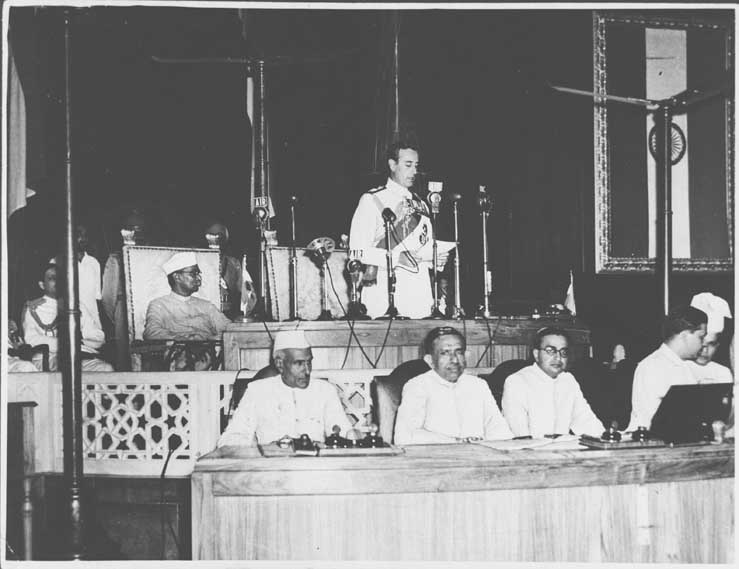
I understand that reading the headlines may provoke anger or make you think that the writer of this article has gone crazy or is seeking cheap publicity. However, I kindly request you to read the entire article before jumping to any conclusions.
Before delving deeper into the topic, it is important to familiarize ourselves with The India Independence Act of 1947. This was passed by Britain’s Parliament shortly before India’s independence date of August 15 1947. It effectively gave independence to two dominion states: India and Pakistan. This law received royal approval on July 18 1947 and came into effect on August 15 encompassing both present-day Pakistan and Bangladesh.
Representatives from many different political parties agreed with Lord Mountbatten, the last viceroy of India about the plan for independence. This agreement was called the June 3 Plan or Mountbatten Plan and it offered a defining plan for independence. Non-violent movements including that of Mahatma Gandhi had played a key role in creating intense opposition against British rule in India.
One result of this situation was that Britain felt pressure after WWII to leave India as part of the process of decolonization. However instead of leaving abruptly like pirates abandoning their ship at sea, they chose to transfer power lawfully so as not to create chaos or disruption from an international perspective. However, despite being a significant constitutional document, the Indian Independence Act of 1947 is relatively less known, even among students of constitutional law.
In May 1947, Lord Mountbatten proposed a plan in which the provinces would be declared independent successor states, granting them the choice to join the constituent assembly or not.
Lord Mountbatten (the last viceroy of India) in May 1947 proposed a plan according to which the provinces would be declared independent successor states with the right to choose whether to join the constituent assembly or not.
History of Mountbatten’s Supply Plan
- Lord Mountbatten arrived in India as the final viceroy and was tasked with transferring control as soon as possible by Clement Utley, the British prime minister at the time.
- Mountbatten came up with the concept in May 1947, suggesting that the provinces be recognized as separate successor governments and given the option to participate in the constituent assembly or not. This scheme was known as the “Dickie Bird Plan” in British and Indian history.
- When Jawaharlal Nehru found out about the idea, he strongly disagreed with it and made it known that he thought it would lead to the Balkanization of India. Thus, the “Balkan Plan” became another common name for this strategy.
- The viceroy then proposed a new strategy, which became known as the “June 3 Plan.” This was the last, best plan for India’s freedom. The term “Mountbatten Plan” is commonly used to refer to this strategy.
- The 3rd of June Plan incorporated the ideas of partition, autonomy, and the right of both states to establish their own constitution.
- For the first time, princely states like Jammu and Kashmir could choose between becoming a part of India or Pakistan. New countries will feel the effects of this decision for decades.
- Congress and the Muslim League both agreed on this approach. By that time, even Congress had accepted partition as inevitable.
- On July 18, 1947, the British Parliament enacted the Indian Independence Act with royal permission, thus kicking off this initiative.
Mountbatten’s Provision Plan
- British India would be partitioned into two independent states, India and Pakistan.
- Muslim-majority territories (which will become Pakistan) will not be bound by the Constituent Assembly’s constitution. A separate constituent assembly for Muslim-majority provinces will be decided upon at the provincial level.
- The legislatures of both Bengal and Punjab convened to approve the partition plan. As a result, the two provinces were split along religious lines.
- The legislature of Sindh will make the final call on whether or not to participate in India’s Constituent Assembly. The decision was made to side with Pakistan.
- The NWFP (Northwest Frontier Province) was going to vote on which domain it wanted to join in a referendum. Despite Khan Abdul Ghaffar Khan’s rejection of the referendum and the NWFP’s decision to join Pakistan, the latter rejected the former.
- On August 15, 1947, control would be officially handed over.
- Sir Cyril Radcliffe presided over the formation of a border commission to define the international boundaries between the two nations. The commission’s job was to create two new countries out of Bengal and Punjab.
- The princely kingdoms might choose to either maintain their independence or join either India or Pakistan. The United Kingdom no longer ruled these countries.
- The princely kingdoms might choose to either maintain their independence or join either India or Pakistan. The United Kingdom no longer ruled these countries.
- The title “Emperor of India” was dropped from the British monarch’s repertoire.
- The new dominions’ territory was not subject to British parliamentary lawmaking after their establishment.
- Until new constitutions develop, His Majesty’s dominions’ constituent legislatures will enact laws through the Governor-General. The Governor-General assumed constitutional leadership responsibilities.
- Pakistan and India both became independent nations at midnight on August 14 and 15, 1947. After India and Massachusetts gained their independence, Lord Mountbatten was named their first Governor-General. Jinnah was appointed as Pakistan’s first Governor-General.
The princely kingdoms that merged with India afterwards signed merger agreements within the Indian sphere of influence. Their delegates took part in deliberations of India’s Constituent Assembly, where the country’s Constitution was drafted.
The Indian Constituent Assembly, vested with the independence granted by the British Parliament and augmented by the princely states, drafted the Indian Constitution and put it into effect on November 25, 1949.
On January 26, 1950, the Republic of India came into existence in this way. The Constituent Assembly of India drew its authority to write the Indian Constitution from the 1947 Act, which was approved by the British Parliament and augmented by the Affiliation Document, which was signed by the princely states.
The words “We the people of India” may serve as a symbolic introduction to India’s Constitution, but the 1947 Act is what gives the document its actual authority in the court of law. There wasn’t a huge group of people who could write India’s constitution all at once. According to the 1947 Act, the Indian Constituent Assembly has the authority to create India’s constitution for all of the former British India. In fact, the Indian Constitution’s Article 395 acknowledges this reality and permits for the “repeal” of the 1947 Act.
The Indian Independence Act is a landmark piece of legislation that has far-reaching implications for Indian law.
The choice of whether to be content with a sham independence or to work together to realize the goals of freedom fighters like Netaji Subhas Chandra Bose, Chandrasekhar Azar, Bhagat Singh, and others who sacrificed their lives for real freedom rather than leased freedom is now in the hands of my readers.
Following their decision to join India, the princely states engaged into merger agreements with the Indian domain. Their representatives actively participated in the Constituent Assembly of India’s discussions regarding the constitution’s formulation.
The Constituent Assembly of India, empowered by the sovereign authority delegated by the British Parliament and supplemented by the princely states, established the Constitution of India on November 25, 1949, which was subsequently ratified. On this date, January 26, 1950, the Republic of India was established. The 1947 Act, ratified by the British Parliament, and the Affiliation Document, signed by the princely states, served as the legal foundation for the Constituent Assembly of India to draft the constitution.
Although the Indian Constitution begins symbolically with the phrase “We the people of India,” its legal authority derives from the 1947 Act. The Indian Constitution was not drafted by a large group of persons. In reality, the 1947 Act grants the Constituent Assembly of India the authority to design the Constitution of India for the territories that formerly comprised British India. Section 395 of the Indian Constitution expressly provisions for the “repeal” of the 1947 Act in recognition of this reality.
The significance of the Indian Independence Act in Indian legal practice should not be understated.
Now, it is up to the readers to decide whether they should celebrate what they perceive to be a sham independence or unite to fulfill the mission of freedom fighters such as Netaji Subhas Chandra Bose, Chandrasekhar Azad, Bhagat Singh, and others who sacrificed their lives for genuine, not leased, independence.
References:
Indian Independence on lease from British for 99 years
D C Gupta vs National Archives Of India
Indian Independence Act 1947
Article 147 of INDIAN PENAL CODE
Indian Independence Act 1947 – CHAPTER 30
Is India Really Under The Lease For 99 Years?




I enjoy you because of your whole effort on this site. Betty really likes managing research and its really simple to grasp why. A number of us hear all of the dynamic manner you give both useful and interesting tactics through the blog and as well as strongly encourage contribution from some others about this subject matter plus our favorite girl is actually discovering a lot of things. Have fun with the rest of the new year. You are always carrying out a really good job.